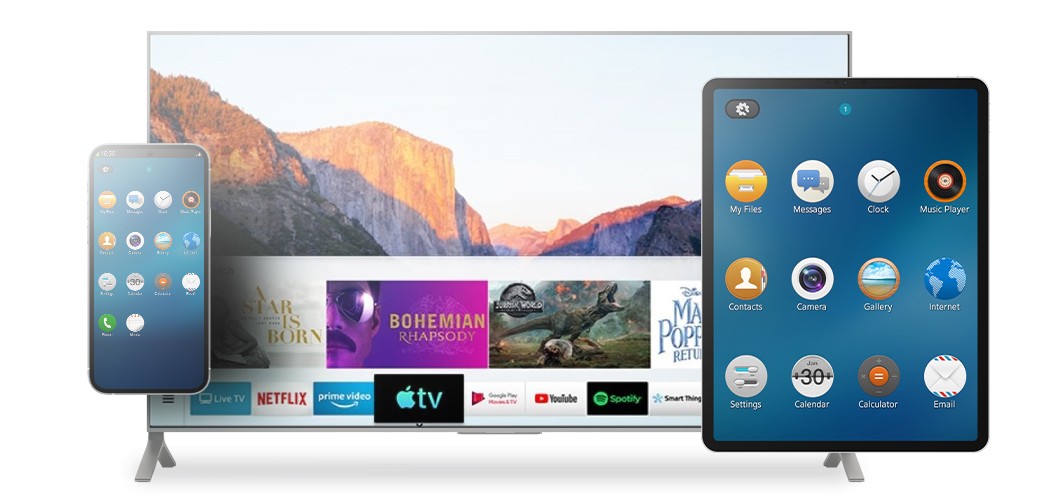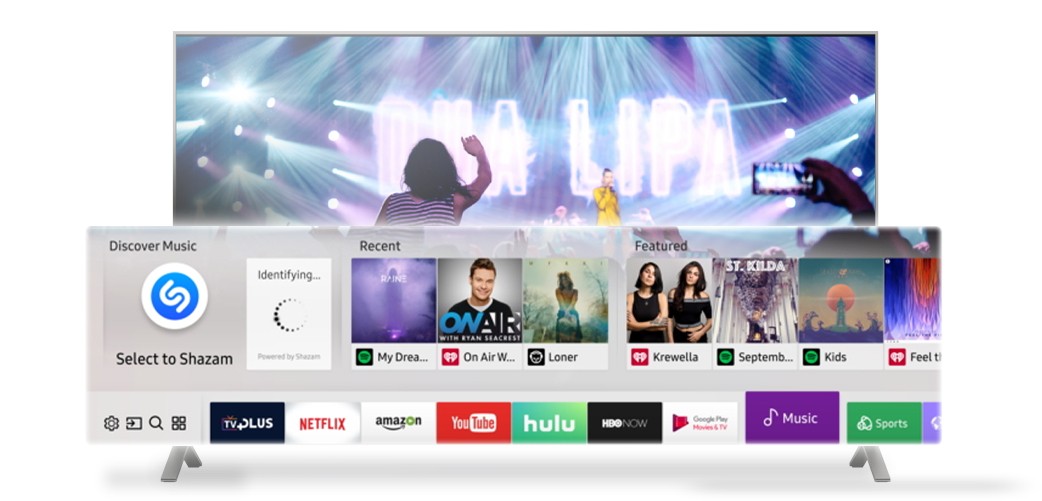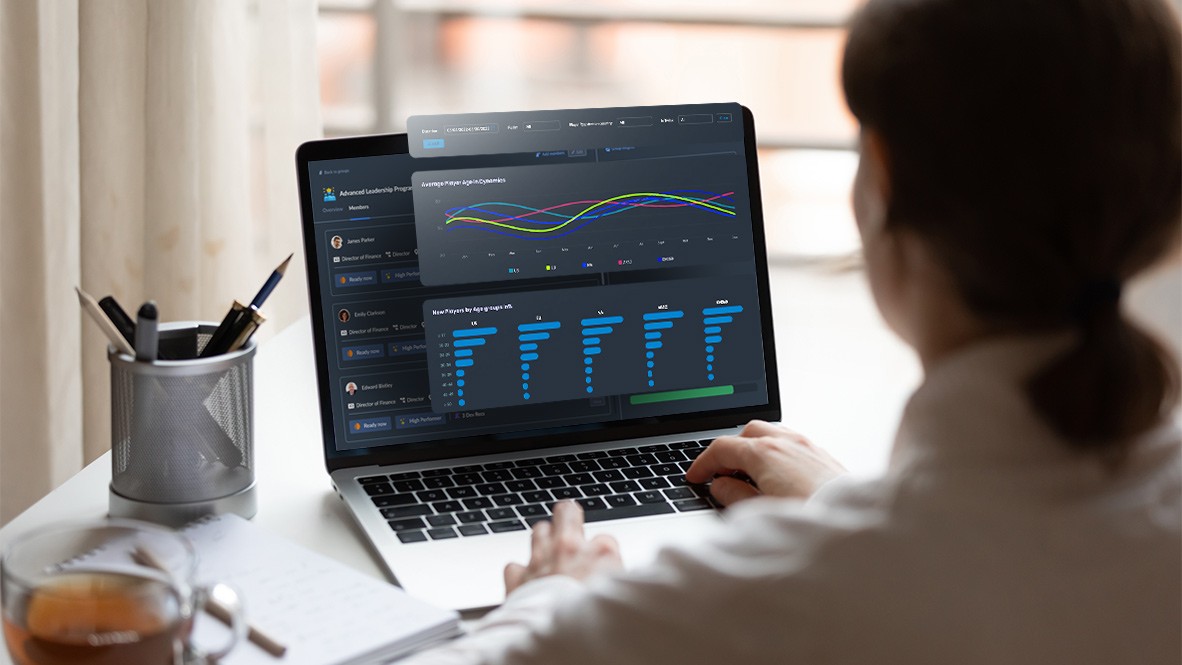Smart TVs have become the central hub for home entertainment, with over 1.1 billion households globally, representing 51% of all households, expected to own a Smart TV by 20261. Samsung maintained its position as the global TV market leader in 2024, achieving a 28.3% market share, marking its 19th consecutive year at the forefront2. Notably, Samsung’s Tizen OS powers a significant portion of these devices, making it the most widely adopted Smart TV operating system worldwide3.
As competition among streaming services intensifies, businesses are increasingly focusing on Samsung Smart TV apps development to expand their reach. Engaging in Tizen OS app development allows content providers to deliver personalized, seamless experiences directly on users’ primary screens, ensuring they stay ahead in the evolving digital landscape.
Samsung Smart TV apps development: Explaining Tizen OS
Samsung’s long-term leadership in the Smart TV space is rooted not only in premium hardware but also in its powerful software foundation. The Tizen operating system, developed in-house and exclusive to Samsung Smart TVs, continues to evolve with each product generation, offering a fast, intuitive, and feature-rich environment that drives user engagement.
Tizen OS has been recognized for its seamless integration across Samsung’s latest Neo QLED and OLED product lines. Samsung’s commitment to pairing innovation in display technology with a consistent and responsive operating system has played a major role in retaining its strong market position. In the U.S., Samsung now accounts for 32% of all connected Smart TVs and is present in 45% of Smart TV households4.
Tizen’s developer-friendly, Linux-based architecture also continues to attract a global developer community, keeping the platform agile and rich in third-party integrations. This openness, combined with Samsung’s scale, reinforces Tizen OS as a strategic foundation for businesses investing in Samsung Smart TV app development or looking to scale through Tizen TV app development.
How to develop apps for Samsung Smart TV in 2025: key things to consider
Among the variety of Smart TV app development platforms, Tizen stands out due to its broad device compatibility, simple and intuitive design, and high performance. Samsung keeps improving the Tizen ecosystem for developers and users alike. Below are the core aspects to keep in mind when working on apps for Samsung Smart TV.
Powered devices
Tizen OS supports a wide range of device types, including TV, IoT, Mobile, and Wearable. The Tizen TV profile offers the tools needed for building apps tailored to Samsung’s extensive Smart TV lineup. In the IoT space, the OS works with both Headed and Headless device configurations. As part of Samsung Tizen TV development, it’s important to consider how your app can fit into Samsung’s broader connected ecosystem.

Devices compatible with Tizen OS
UI and design
Tizen OS maintains a harmonious TV application look, following the principles of simplicity, focus, and visual space. Since version 3.0, the platform uses the Wayland protocol for smoother graphics and system efficiency. The latest releases, including Tizen 7.0, introduce new UI capabilities such as voice-assisted Mini Avatars and spatial rendering through a unified engine. These improvements give more creative flexibility to every Samsung Smart TV Tizen developer and add to the user experience.
UX
Smart TV applications are built for the living room experience, often referred to as the “lean-back” mode. This involves attention to text size, remote control navigation, and clarity of user focus. Tizen UX guidelines recommend predictable on-screen movement and minimal transitions. Features like Voice Touch and Bixby help streamline navigation through voice commands, enhancing overall usability for diverse audiences.

Tizen OS design
Performance
TV apps run on a range of devices with different memory and CPU capabilities. Memory usage optimization and early detection of memory leaks are still essential best practices. This is especially important for apps intended to support older models or lighter devices. Within Tizen OS development, engineers should focus on balancing performance and stability across the full device spectrum.
Alexander Skamarokha, Performance QA Engineer
Explaining feature-driven development when tailoring it to low-end devices’ specifics
“For enhancing performance on Samsung Smart TVs, we adhere to a feature-driven development approach that involves adjusting capabilities for weaker hardware. Some functionality may require higher capacities for smooth operation, so in this case, the code is optimized to disable such features for low-end devices. For instance, animation performs efficiently on Tizen 6.0, while for Tizen 4.0, it’s reasonable not to use it to improve performance indicators.
Unfortunately, online video streaming providers may not consider the specifics of low-end devices in advance, mostly targeting later Tizen versions. Still, for some regions, it matters, as research shows that in developing countries, older yet cheaper Smart TVs are widely used by households.”
Case in point: Superior performance on all devices for a leading telecom operator
We ensured the seamless delivery of content, preventing potential slowdowns or freezes for users, including on low-performance devices, by:
- Reducing memory consumption with adaptable cache configurations applied to minimize system load.
- Enhancing system stability by detecting and preventing memory leakage issues.
- Applying the best development practices to speed up rendering.

Security and compliance
Security and privacy are critical parts of any Tizen-based solution. Developers are expected to use secure APIs, encrypt all communication, and comply with local data regulations like GDPR and CCPA. Apps that involve payments, login, or profile management go through additional certification steps to meet Samsung’s updated security standards.
Certification and testing
Samsung has refined its app submission and review process. Apps must now support multiple screen sizes and resolutions, with proper layout scaling for different devices. Testing in the latest Tizen Emulator is required before submitting via the Samsung Seller Office. This ensures consistent quality across the Samsung Smart TV custom apps ecosystem.
Monetization and ad integration
The CTV advertising market continues to grow, and Samsung offers built-in tools for app monetization. The Samsung Ads SDK allows for dynamic ad placement within AVOD apps. Developers need to follow the current ad policy and ensure child-safe ad display logic where needed. These options make Smart TV apps a viable commercial channel.
SmartThings & cross-device logic
Many Samsung users now rely on connected devices through the SmartThings ecosystem. Developers are encouraged to build apps that integrate with SmartThings Cloud APIs, enabling cross-device interactions and second-screen functionality. This continuity strengthens user experience and aligns well with long-term development goals.
Energy efficiency
Samsung promotes sustainable development practices across its platforms. Apps that manage memory and CPU use efficiently can reduce energy consumption and improve hardware longevity. Energy-conscious behavior, like avoiding unnecessary updates or background processes, is rewarded with faster certification and better store visibility.
App submission process
The app submission process remains a crucial step in TV app development. Developers are required to follow the Distribution Guide and prepare a representative image using the Tizen Widget Checklist, which also covers licensing requirements for Samsung TV apps. Before launch, ensure full compliance with Samsung’s packaging standards and run mandatory pre-submission tests using the latest Tizen Emulator. Once certified, the widget pack can be submitted via the Samsung Apps TV Seller Office.
To ensure successful submission, it’s essential to account for multi-device compatibility, regional availability, performance benchmarks, and custom features. Geo-targeted functionality must now be explicitly documented. Teams should also be prepared to communicate with Samsung QA engineers to align the app’s behavior with current Tizen versions and ensure a smooth experience across all supported regions and devices.
How to pick a reliable Samsung Tizen TV app development vendor
One of the key steps on the way to successful TV app building is the choice of a solid Tizen developer. Though the selection process might be a tough one, choose a vendor who has:
Strong portfolio
Searching for a high-profile vendor to develop a Tizen TV app, take a closer look at the case studies pack. The list of partners, successfully implemented projects, their backgrounds, and challenges met along the way will help you understand the way the developer company approaches issues. Apart from that, a strong portfolio provides a comprehensive idea of the vendor’s high-level expertise, which is essential for any customer looking for a partner to rely on. For example, a partner’s in-depth knowledge about hardware capacities may save you money on Smart TV app performance optimization, as due to their expertise, they may eliminate performance issues before the app goes to market.
How we can help
Let’s discuss the opportunities of Tizen app development for your business.
Flexible approach
Avoid developer vendors who are attracted to the one-size-fits-all approach. The idea of custom app development is to stand out from the rest of the companies by being innovative and recognizable, so why settle for less? Partner up with a company that thinks outside the box and perceives each project as a unique piece of work.
Wrapping up
Looking for ways to boost your business growth and take it to a new level? Consider building your digital products with Tizen. Developing apps for Samsung Smart TV via its open-source OS is an option for companies that are targeted at continuous growth and improvement by reaching new audiences, uncovering niches, and expanding service offerings via exploring new platform opportunities.
Your multi-screen evolution starts here
Bring your content to every screen that matters — let’s discuss multi-screen development to expand your reach, elevate user experiences, and deliver unmatched engagement.
Sources:
1. Broadband TV News — Global smart TV ownership to exceed 50% by 2026
2. Samsung Newsroom — Samsung Electronics Marks 19 Consecutive Years as the Global TV Market Leader
3. Broadband TV News — Samsung Leads in CTVMA’s Global Smart TV OS Rankings
4. StreamTV Insider — Samsung Leads U.S. CTV Market Increasingly Dominated by Smart TVs



























